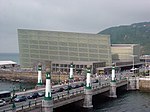San Sebastián

San Sebastian, officially known by the bilingual name Donostia / San Sebastián (Basque: [doˈnos̺ti.a], Spanish: [san seβasˈtjan]), is a city and municipality located in the Basque Autonomous Community, Spain. It lies on the coast of the Bay of Biscay, 20 km (12 miles) from the France–Spain border. The capital city of the province of Gipuzkoa, the municipality's population is 188,102 as of 2021, with its metropolitan area reaching 436,500 in 2010. Locals call themselves donostiarra (singular), both in Spanish and Basque. It is also a part of Basque Eurocity Bayonne-San Sebastián. The economic activities in the city are dominated by the service sector, with an emphasis on commerce and tourism, as San Sebastian has long been well-known as a tourist destination. Despite the city's small size, events such as the San Sebastián International Film Festival and the San Sebastian Jazz Festival have given it an international dimension. San Sebastian, along with Wrocław, Poland, was the European Capital of Culture in 2016.
Excerpt from the Wikipedia article San Sebastián (License: CC BY-SA 3.0, Authors, Images).San Sebastián
Kanpandegi, San Sebastián Parte Zaharra - Parte Vieja (Erdialdea)
Geographical coordinates (GPS) Address Website Nearby Places Show on map
Geographical coordinates (GPS)
| Latitude | Longitude |
|---|---|
| N 43.321388888889 ° | E -1.9855555555556 ° |
Address
Donostiako Udaletxea
Kanpandegi
20003 San Sebastián, Parte Zaharra - Parte Vieja (Erdialdea)
Autonomous Community of the Basque Country, Spain
Open on Google Maps










